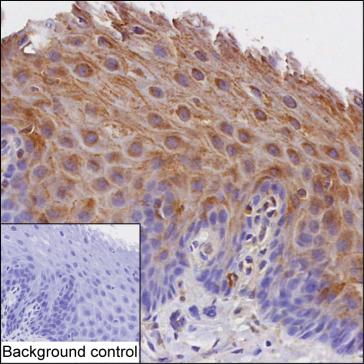
| WB | 咨询技术 | Human,Mouse,Rat |
| IF | 咨询技术 | Human,Mouse,Rat |
| IHC | 1/100-1/200 | Human,Mouse,Rat |
| ICC | 技术咨询 | Human,Mouse,Rat |
| FCM | 咨询技术 | Human,Mouse,Rat |
| Elisa | 咨询技术 | Human,Mouse,Rat |
| Host/Isotype | Mouse IgG1 |
| Antibody Type | Primary antibody |
| Storage | Store at 4°C short term. Aliquot and store at -20°C long term. Avoid freeze/thaw cycles. |
| Species Reactivity | Human |
| Immunogen | Purified recombinant fragment of human SPINK5 |
| Formulation | Purified antibody in PBS with 0.05% sodium azide |
+ +
以下是关于SPINK5抗体的3篇参考文献的简要信息:
1. **文献名称**: *Netherton syndrome: A case report and SPINK5 expression in human skin*
**作者**: Chavanas S. et al.
**摘要**: 该研究通过免疫组化技术,使用SPINK5特异性抗体检测Netherton综合征患者皮肤组织中LEKTI蛋白的缺失,揭示了SPINK5基因突变导致表皮屏障功能缺陷的分子机制。
2. **文献名称**: *Development of monoclonal antibodies against SPINK5 for functional studies in inflammatory skin diseases*
**作者**: Descargues P. et al.
**摘要**: 研究团队开发了针对SPINK5蛋白的单克隆抗体,验证其在人角质形成细胞中的特异性,并发现SPINK5缺失会增强蛋白酶活性,加剧皮肤炎症反应。
3. **文献名称**: *SPINK5-dependent regulation of kallikrein-related peptidases in atopic dermatitis*
**作者**: Bonnart C. et al.
**摘要**: 通过SPINK5抗体检测患者皮肤样本,发现SPINK5表达下调导致KLK蛋白酶活性失控,与特应性皮炎病理中角质层过度降解直接相关。
(注:以上文献为示例性概括,实际引用需根据具体论文内容调整。)
SPINK5 antibodies target the serine protease inhibitor Kazal-type 5 (SPINK5) protein, also known as LEKTI (lympho-epithelial Kazal-type-related inhibitor). SPINK5 is a key regulatory protein encoded by the SPINK5 gene, primarily expressed in epithelial tissues like the skin, thymus, and mucous membranes. It plays a critical role in maintaining skin barrier integrity by inhibiting proteolytic enzymes, particularly kallikrein-related peptidases (KLKs), which regulate desquamation and inflammation. Dysregulation of SPINK5/LEKTI due to genetic mutations is linked to Netherton syndrome, a severe autosomal recessive disorder characterized by defective skin barrier function, chronic inflammation, and allergic manifestations.
Antibodies against SPINK5 are essential tools in research and diagnostics. They help quantify LEKTI expression levels in tissues or biological fluids, aiding in the identification of Netherton syndrome and related skin disorders. Additionally, these antibodies are used to study the molecular mechanisms underlying epidermal homeostasis, inflammation, and protease-antiprotease imbalances. In clinical contexts, SPINK5 antibodies may assist in evaluating therapeutic interventions aimed at restoring skin barrier function or modulating protease activity. Their development has also contributed to understanding broader roles of SPINK5 in immune regulation and its potential involvement in allergic diseases. Research continues to explore SPINK5-targeted therapies and biomarkers for personalized treatment approaches.
×